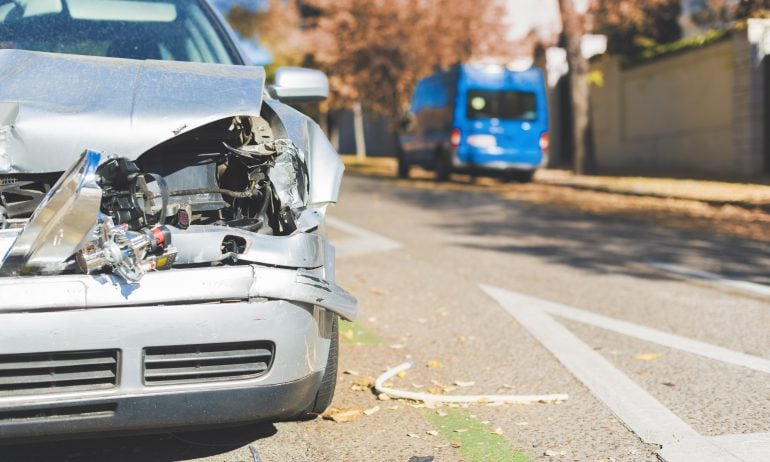How Much Does Insurance Increase After an Accident?

Many, or all, of the products featured on this page are from our advertising partners who compensate us when you take certain actions on our website or click to take an action on their website. However, this does not influence our evaluations. Our opinions are our own. Here is a list of our partners and here's how we make money.
Nerdy takeaways
An at-fault accident can increase your auto insurance rates for at least three years, depending on your state and insurer.
A driver with a recent at-fault accident pays $808 more a year on average for a full coverage policy than a driver with no traffic violations.
How much insurance increases after an accident depends on your insurer.
Shop around and compare rates to find cheaper car insurance after an accident.
Full coverage car insurance rates can go up an average of 47% a year if you cause an accident, NerdWallet’s June 2024 analysis found.
But if you switch to the cheapest auto insurer in your state, you may find better rates.

See what you could save on car insurance
Easily compare personalized rates to see how much switching car insurance could save you.How an accident affects your car insurance rates
An accident typically affects your car insurance rates for at least three years, although this varies by state and insurance provider. Even if it was a minor crash, insurers perceive you as a greater risk and will almost always increase your rates.
NerdWallet did an analysis to see how much car insurance can increase after an accident. We compared average car insurance rates nationwide for 35-year-old drivers with a recent at-fault crash to those with no recent accidents, keeping all other factors the same. We used full coverage insurance policies for a 2021 Toyota Camry LE and a hypothetical accident that resulted in $10,000 worth of property damage and no injuries.
| Type of policy | Clean record | One at-fault accident |
|---|---|---|
| Full coverage | $1,718 | $2,526 |
| Minimum coverage | $488 | $725 |
Our analysis found that nationwide, a driver with an at-fault accident pays $808 more a year on average for a full-coverage policy than a driver with no traffic violations.
However, this is based on average rates. Your rate may differ depending on factors like your age, location and insurer.
» MORE: Average car insurance costs

Cheap car insurance after an accident by company
Car insurance companies have wildly different viewpoints on how much to raise rates due to a crash. In some instances, companies might not raise their rates after a small accident. In others, rates can go up an exorbitant amount.
NerdWallet’s latest analysis of some of the nation’s largest insurers found that average rates for a driver with an at-fault accident can go up as much as 70%, or as little as 28%.
That’s why it’s essential to compare car insurance rates from several companies to find cheap auto insurance after an accident.
To see how the largest insurers price policies after at-fault accidents, we looked at median national rates from each of these companies for drivers with an at-fault accident on their record.
Out of these companies, Travelers returned the lowest average rates for drivers who’d caused an accident. State Farm showed the smallest percentage increase in rates between drivers with a clean record and those with a recent crash.
Average rates from the biggest auto insurers after an at-fault crash
| Company | Clean record | One at-fault accident |
|---|---|---|
| Allstate | $2,258 | $3,491 |
| American Family | $1,279 | $2,143 |
| Farmers | $2,578 | $4,106 |
| Geico | $1,306 | $2,208 |
| Nationwide | $1,829 | $2,937 |
| Progressive | $1,725 | $2,511 |
| State Farm | $2,006 | $2,572 |
| Travelers | $1,405 | $1,890 |
| USAA* | $1,259 | $1,848 |
*USAA is only available to military, veterans and their families.
For drivers who qualify, USAA frequently has some of the lowest rates we found, both before and after an accident. But in some cases, USAA is no longer the cheapest option once a driver has caused an accident.
So whether you’re insured with USAA or another company, it’s smart to compare car insurance rates after an accident.
Cheap car insurance after an accident by state
Wondering which companies are the most likely to offer cheap car insurance after a crash? Find your state below to see the cheapest car insurance rates after an accident on average based on where you live.
To find the cheapest insurer after a crash in each state, NerdWallet’s analysis looked at full coverage rates for all ZIP codes in all 50 states and Washington, D.C., for a 35-year-old driver with good credit and a recent at-fault accident. Although USAA is the cheapest option in many states, we didn’t include the company in this table since its policies are available only to active military members, veterans and their families.

See what you could save on car insurance
Easily compare personalized rates to see how much switching car insurance could save you.It’s possible to get a lower rate after an accident
Shopping around after an accident is the best way to ensure you are getting the cheapest rate, and our analysis shows why:
Shopping for the cheapest car insurance after a crash could save you big. Our analysis shows that shopping for the cheapest possible rate after a crash could potentially save you thousands a year, depending on your state and insurer.
No single car insurance company is cheapest for everyone. Your rate will be determined based on your personal characteristics and your specific situation.
The cheapest insurer before an accident may not be the cheapest afterward. In some of the states we looked at, some drivers who were insured with the cheapest company available would need to switch insurers to continue getting the lowest possible rates after an accident.
Big-name insurance companies aren’t always cheapest. Although the nation’s 10 largest car insurance companies together account for around 75% of the car insurance market, smaller companies sometimes offer the lowest rates after an accident.
How to find cheap car insurance after an accident
Shopping around is the best way to find the cheapest rate, but there are other ways to ensure you are getting the lowest rate possible. You may be able to avoid an insurance rate increase after an accident by:
Raising your deductible, which is the amount reduced from a potential claim check from comprehensive or collision insurance. This will cause a greater out-of-pocket cost to repair your own car if you get into an accident in the future.
Adding discounts to your policy. Discounts could help offset the increase in your rate from the accident. Check with your insurer or agent to see if any more are available to you.
Improving your credit. While improving credit is a long-term strategy, a healthy credit report will likely result in a more affordable car insurance rate in most states.
» MORE: Cheapest car insurance companies
Do insurance rates go up after a no-fault accident?
If you weren’t to blame for an accident, you might see an increase in your auto insurance rate anyway. A 2017 study by the Consumer Federation of America, the most recent data available, found that some companies raise rates 10% or more for not-at-fault accidents.
In no-fault states, everyone involved in an accident files a claim to their own insurer for injuries. Because of this, residents of those states may see rate increases after an accident, no matter who is at fault.
A few states, including Oklahoma and California, don’t allow insurers to increase your rates if a crash was not your fault. Some companies, such as USAA, even say they usually won’t raise rates if you aren’t responsible for an accident.
But regardless of whether the accident was your fault, it’s always a good idea to compare car insurance quotes to make sure you’re getting the lowest price.
Can I keep my car insurance rate from going up after a crash?
If you have accident forgiveness on your policy and this is your first accident, it’s likely that your rate won’t go up. Accident forgiveness is an optional coverage type many insurers offer that prevents your car insurance premium from increasing after your first accident.
This coverage typically costs extra, but some insurers offer free accident forgiveness to drivers who have gone without an accident for a certain period, often around five years.
» MORE: Get free car insurance quotes
Alternative car insurance for high-risk drivers
If you have multiple accidents or other serious marks on your record, you may be classified as a high-risk driver. High-risk drivers generally have a harder time finding coverage because they are considered risky to insure.
If no one will sell you a policy, you may need to look for a state-run assigned risk plan. To find an insurer, locate your state in the directory of the Automobile Insurance Plan Service Office, an industry organization, or ask your auto insurance agent for help. This is considered a “high-risk insurance pool,” in which the state assigns an insurer to you.
NerdWallet averaged rates based on public filings obtained by pricing analytics company Quadrant Information Services. We examined rates for men and women for all ZIP codes in all of the 50 states and Washington, D.C. Although it’s one of the largest insurers in the country, Liberty Mutual is not included in our rates analysis due to a lack of publicly available information.
In our analysis, “good drivers” had no moving violations on record; a “good driving” discount was included for this profile. Our “good” and “poor” credit rates are based on credit score approximations and do not account for proprietary scoring criteria used by insurance providers.
These are average rates, and your rate will vary based on your personal details, state and insurance provider.
Sample drivers had the following coverage limits:
$100,000 bodily injury liability coverage per person.
$300,000 bodily injury liability coverage per crash.
$50,000 property damage liability coverage per crash.
$100,000 uninsured motorist bodily injury coverage per person.
$300,000 uninsured motorist bodily injury coverage per crash.
Collision coverage with $1,000 deductible.
Comprehensive coverage with $1,000 deductible.
In states where required, minimum additional coverages were added. We used the same assumptions for all other driver profiles, with the following exceptions:
For drivers with minimum coverage, we adjusted the numbers above to reflect only the minimum coverage required by law in the state.
We changed the credit tier from “good” to “poor” as reported to the insurer to see rates for drivers with poor credit. In states where credit isn’t taken into account, we only used rates for “good credit.”
For drivers with one at-fault crash, we added a single at-fault crash costing $10,000 in property damage.
For drivers with a DUI, we added a single drunken-driving violation.
For drivers with a ticket, we added a single speeding violation for driving 16 mph over the speed limit.
We used a 2020 Toyota Camry L in all cases and assumed 12,000 annual miles driven. We analyzed rates for drivers of the following ages: 20, 30, 35, 40, 50, 60 and 70.
These are rates generated through Quadrant Information Services. Your own rates will be different.
On a similar note...


